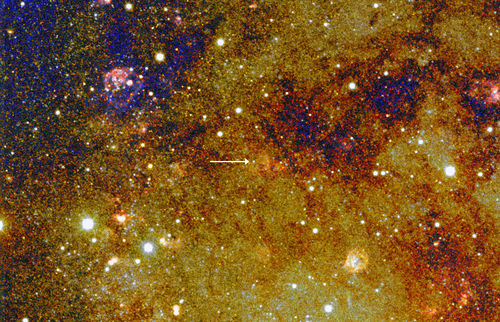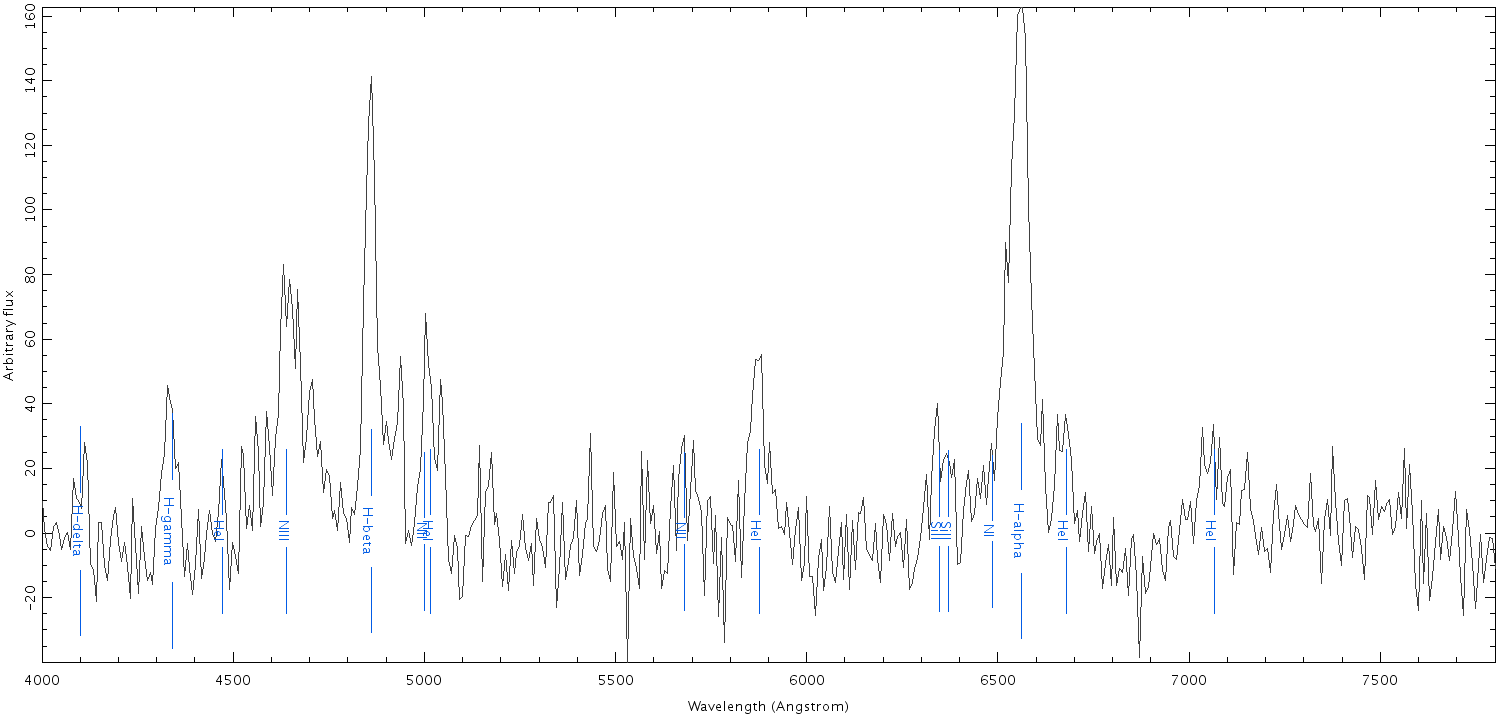 A quasi-true colour LT image of the region
of M31 around M31N 2008-12a. The yellow backdrop is the unresolved
stellar population of the disk of M31, where the dark patches are
regions of high extinction. The majority of the point sources seen in the
image are in the foreground and belong to our own Galaxy. The image
has been enhanced by the use of a 'H-alpha' image to highlight regions
of excited Hydrogen gas. The nova can be seen in eruption in the
centre of the image (marked by the white arrow).
A quasi-true colour LT image of the region
of M31 around M31N 2008-12a. The yellow backdrop is the unresolved
stellar population of the disk of M31, where the dark patches are
regions of high extinction. The majority of the point sources seen in the
image are in the foreground and belong to our own Galaxy. The image
has been enhanced by the use of a 'H-alpha' image to highlight regions
of excited Hydrogen gas. The nova can be seen in eruption in the
centre of the image (marked by the white arrow).
The LT has in recent weeks been doing what it does best: making exciting discoveries in time domain astronomy! A team led by Dr Matt Darnley of the Astrophysics Research Institute at LJMU has detected the latest eruption of a remarkable Recurrent Nova (RN) in the nearby galaxy M31. This object is particularly noteworthy because of the frequency of its eruptions. Most RNe undergo an outburst once every 10-100 years; the RN in M31 seems to erupt annually.
Darnley and his team were the first to spot the latest eruption of the nova and, thanks to the LT's robotic capabilities, have been able to monitor the event with images and spectra obtained every few hours/days over a period of a few weeks. They have certainly not let the grass grow under their feet, having made full use of the recently-commissioned optical spectrograph, SPRAT.
Novae are associated with nuclear explosions on the surface of a white dwarf, which results in a sudden brightening of the star. Recurrent nova outbursts are caused by the accretion of material from a companion star, usually a red giant, onto the white dwarf through an accretion disc.
As reported in an LT news item earlier this year, the true recurrent nature of the nova system in M31, designated M31N 2008-12a, was characterised following its fifth detected optical eruption in 2013. An international study co-led by Darnley and Dr Martin Henze of the European Space Astronomy Centre in Spain, along with independent work by the Intermediate Palomar Transient Factory (iPTF), uncovered the progenitor system of M31N 2008-12a and inferred the presence of an extremely high mass white dwarf as well as a high mass accretion rate. These are the tell-tale signs that M31N 2008-12a may one day evolve into a Type Ia Supernova explosion.
Such a high mass white dwarf leads to a very rapid evolution of the 'optical lightcurve' of each eruption. The nova fades very rapidly post-eruption. Consequently, despite five optical eruptions and three separate X-ray detections of the event in recent years, very little was known about the behaviour of the system during its eruptions - until now.
In anticipation of a sixth eruption towards the end of 2014, Darnley has been leading a campaign on the Liverpool Telescope (LT) to monitor M31N 2008-12a to detect any changes in its behaviour. This LT campaign was also designed to react rapidly following a newly detected eruption, to obtain as much data on the system as possible.
Nightly monitoring of M31N 2008-12a by the LT began towards the end of July 2014, and just before 10pm (GMT) on 2nd October a sixth eruption was detected. As planned, intensive photometric monitoring of the eruption using the IO:O optical imaging CCD camera on the LT was immediately implemented. In addition, and for the first time, the team deployed the newly commissioned SPRAT (SPectrograph for the Rapid Acquisition of Transients) instrument on the LT, a low-resolution though high throughput spectrograph designed specifically for the classification of transients like novae.
Remarkably, SPRAT has been mounted on the LT for less than a month before Darnley et al. used it to obtain the first spectra of an extragalactic nova ever taken with the LT. These data have led to spectroscopic confirmation of the nature of the eruption and have allowed the team to determine the expansion velocity of its ejecta.
As well as Matt Darnley and Martin Henze, the international collaboration also includes; Mike Bode (LJMU), Steve Williams (LJMU), Allen Shafter (San Diego State University, USA), Jan-Uwe Ness (ESAC), and former LJMU PhD student Rebekah Hounsell (Space Telescope Science Institute, USA). Iain Steele, Rob Smith, and Andrzej Piascik, all from the LT Group at LJMU, were instrumental in obtaining and analysing the SPRAT spectroscopic observations.



